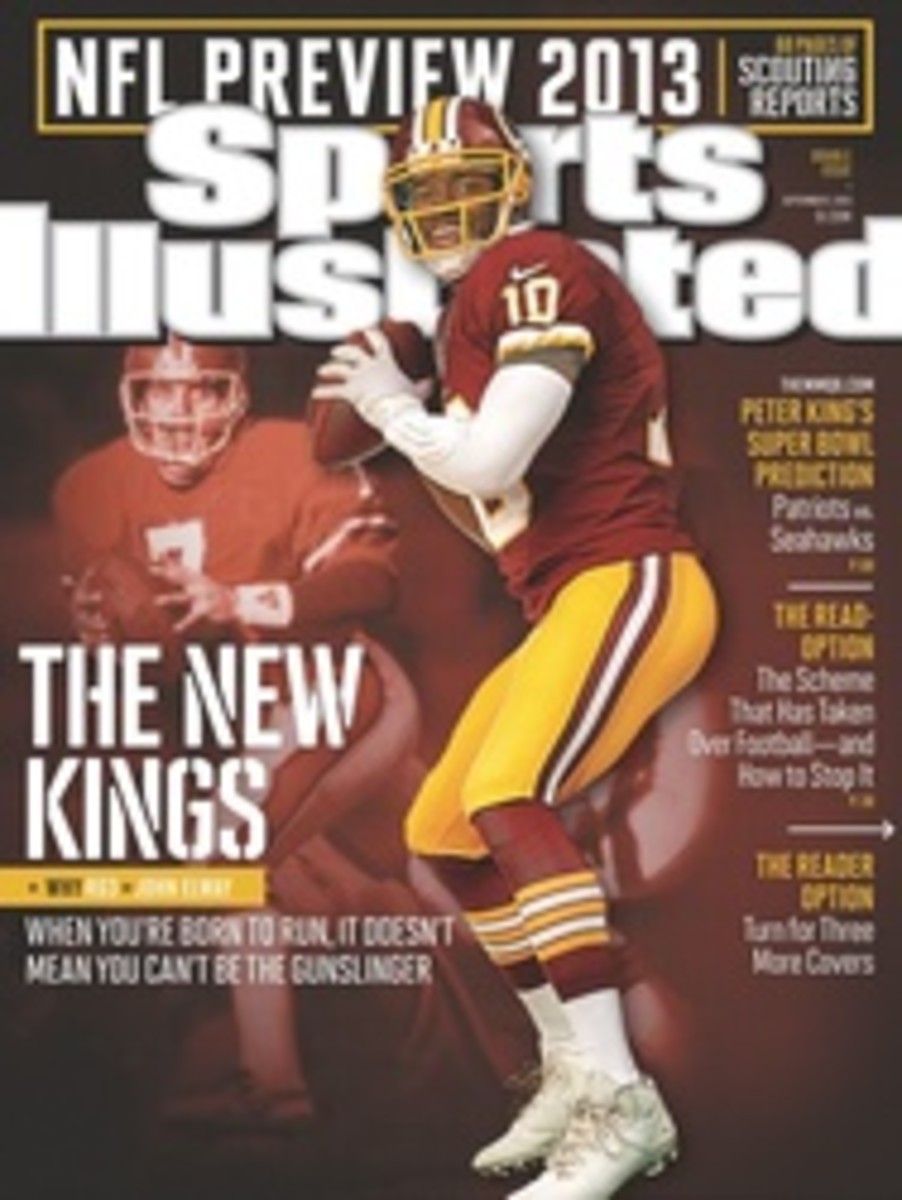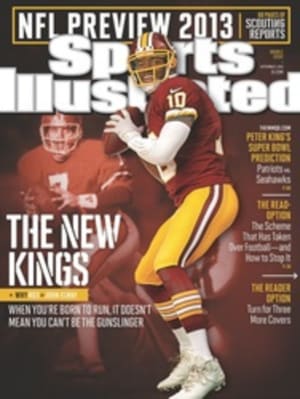
11 St. Louis RAMS
LAST SEASON, as quarterback Sam Bradford struggled to bond with a crew of young Rams receivers, the long ball went dormant. Despite an arm well-suited to going deep, Bradford was 26th in the league in yards per attempt (a measly 6.72 per throw), occasionally making a downfield connection with rookie Chris Givens but mostly living in the middle of the field with Danny Amendola and safety-valve throws.
That all changed in free agency and on draft day. And training camp confirmed just what St. Louis brass thought it had in two new players: tight end Jared Cook and West Virginia slot receiver--utility weapon Tavon Austin—but mostly with Austin.
Over the last month or so the team has grown confident Cook will easily replace Amendola's sure-handedness in the middle of the field. The former Titan had a tremendous camp, showing the catch radius of Jeremy Shockey in his prime and the athleticism downfield of today's Jimmy Graham. Need a star tight end in fantasy football? Cook, barring an injury, will not let you down.
Austin, however, showed signs of being the kind of singular weapon that no other player in the 2013 draft can be, even as a 5' 8", 176-pound mite. (The closest thing, Minnesota's Cordarrelle Patterson, does not have Austin's quickness.) As he ran short curls and deep go routes with equal speed in training camp, one had to wonder, the way he stopped on the eight-yard curl, for instance: How can a man break that fast when turning to the quarterback? And how can a defender adjust to it? The way he ran on deep stuff made it obvious that he'll be a tough match for the fastest corners in football.
One play, in particular, showed how serious a challenge Austin could give defenses this year. Lining up in the slot on a hot St. Louis afternoon, with veteran cornerback Cortland Finnegan a couple of yards off him, Austin sprinted forward at the snap of the ball, Finnegan pedaling furiously in reverse. When Austin stopped after eight yards, Finnegan continued backpedaling a couple of steps; he simply couldn't break in time. Bradford targeted Austin just as the receiver turned around to look for the ball, and it was an easy 12-yard completion. Afterward Finnegan said, "If I think he's going to do that little eight-yard curl and I play him tight, then I might be able to stop it. But if he reads that, he can blow past me, and then he's off for a deep one, and there's no way I can catch up after I've committed to the eight-yard route. He's going to be a headache [to cover]."
Austin has been careful in his first few months as a pro to stay in his rookie lane. No outlandish quotes, no Chad Johnson--like predictions. He wants to fit in, and he doesn't want to give any defenses the I-will-dominate bulletin-board material that many young players come with, even if he did earn that right as the Swiss Army Knife of offensive weapons in college. (He caught 14 balls for 215 yards against Baylor; he rushed for 344 yards in his first-ever game at running back, against Oklahoma; and he returned kicks for touchdowns in his freshman and senior years.)
"The thing I've learned in my short time here, I have to give credit to Danny Amendola for," Austin said one August day during camp. "I watched a lot of tape on Danny and how he played the slot here, and I saw he ran all his routes at full speed. Especially on long drives, I can tell you that's hard to do. But Danny ran every route the same. So that's something I'm going to do. Make every route the same. No tip toeing."
The difference between the pros and college, Austin believes (beyond playing his home games on the fast track of the Jones Dome in St. Louis), will be his ability to get off the bump at the line of scrimmage quickly so the quarterback doesn't have to wait to make a decision on which receiver he's targeting. "That's the thing I'm working hard at—getting away from man coverage at the line—but I think I'll be able to," he says.
"I wasn't much for studying in college, but I did love studying football."
Music to Bradford's ears.
THE CASE FOR...
The secondary
The Rams had been waiting for a pass rush since 2008, when they drafted DE Chris Long No. 2. It took four years, but that plan finally came to fruition in '12: Long and fellow end Robert Quinn ('11, first round) combined for 22 sacks, and last season's top pick, DT Michael Brockers, became the kind of interior force that drove offenses to pay more attention to the inside rusher and less to the outside guys. If CB Janoris Jenkins (left) can stay on the straight and narrow, the Rams have the secondary to survive in a division that features games against Colin Kaepernick, Russell Wilson and Carson Palmer six times a year. Jenkins played opportunistically and inconsistently in '12, scoring four TDs on returns but brain-locking at times. He missed one game for violating team rules. The Rams wanted him to train in St. Louis in the off-season; he stayed in Florida, another letdown. Jenkins might just be the kind of player from whom you get four years on the rookie contract and whom you pass on when his deal expires, but for now he and Cortland Finnegan make a good pair for a Jeff Fisher D: physical, risk-taking CBs who give the Rams a chance at big game-turning plays.
SINCE YOU'VE BEEN GONE
(R) Rookie— College stats
PHOTO
JEFF CURRY/USA TODAY SPORTS
WR TAVON AUSTIN
PHOTO
TOM DIPACE

